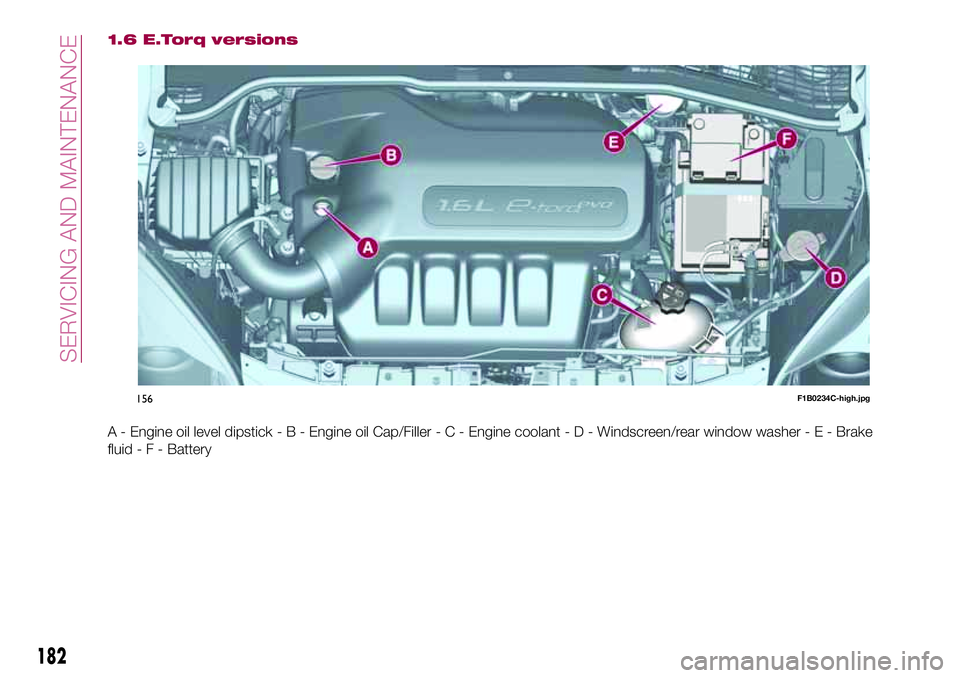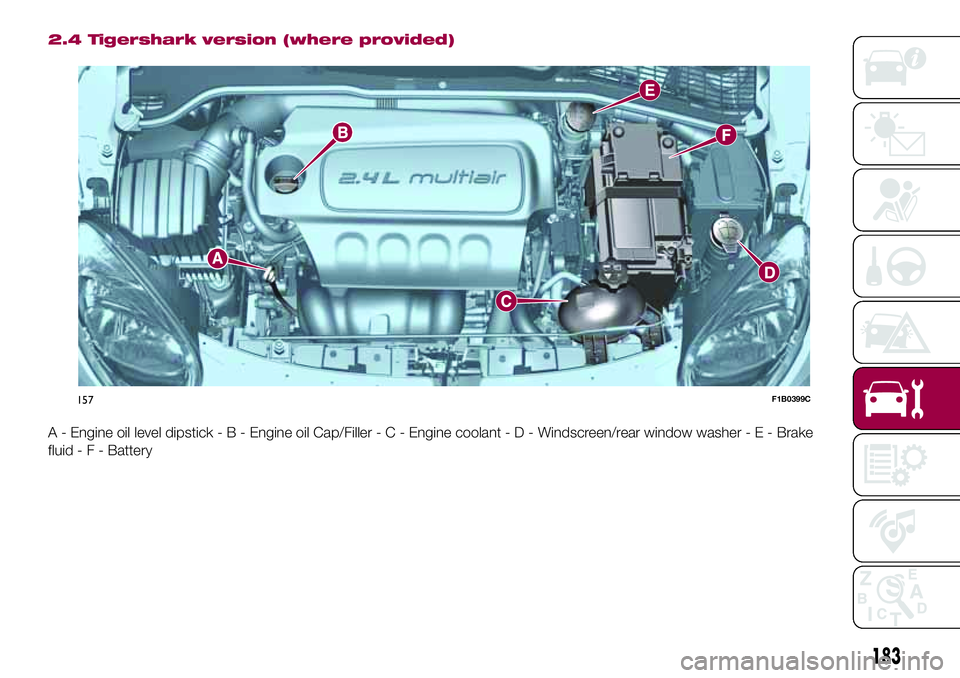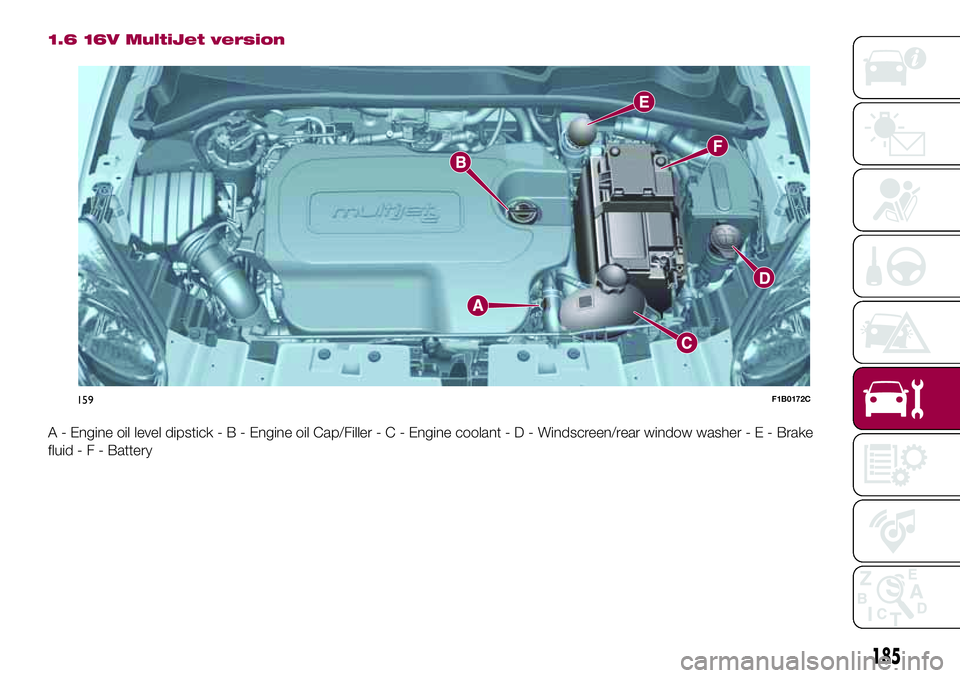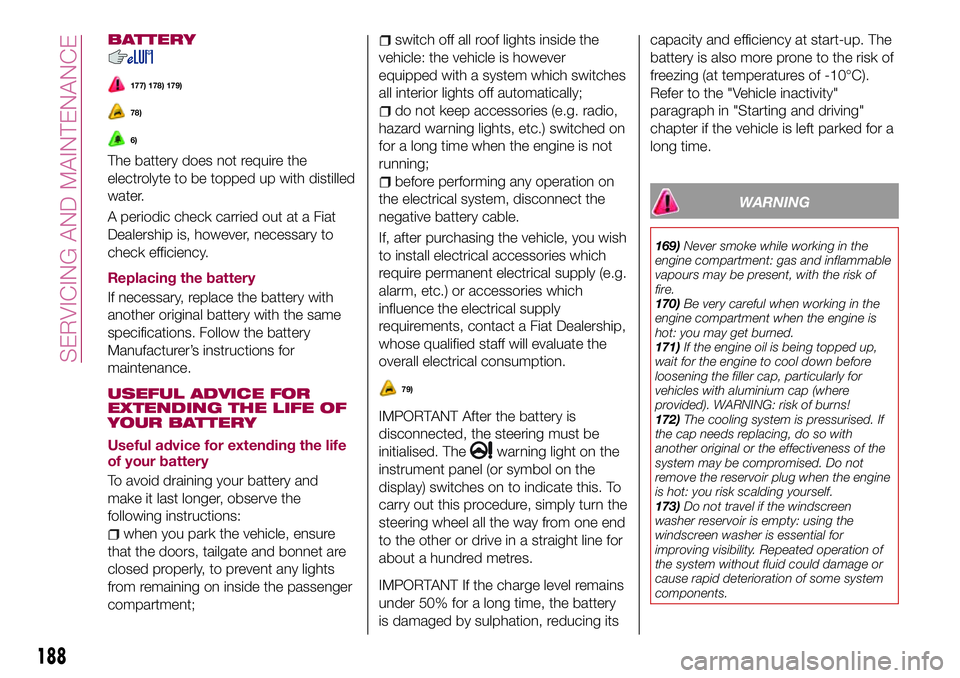FIAT 500X 2017 Owner handbook (in English)
Manufacturer: FIAT, Model Year: 2017, Model line: 500X, Model: FIAT 500X 2017Pages: 284, PDF Size: 11.14 MB
Page 181 of 284

Thousands of kilometres20 40 60 80 100 120 140 160 180 200
Years12345678910
Replace toothed timing drive belt (excluding 1.3 Multijet
16V versions)(4)
Replace fuel filter cartridge (5)
●●●
Replace the air filter cartridge (6)●●●●●
Change the brake fluid(7)
Replace the passenger compartment filter (6) (O) (●)
●●●●●
(4) Areas that are not dusty: recommended maximum distance 120,000 km. The belt must be replaced every 6 years, regardless of distance
travelled. Dusty areas and/or heavy conditions (cold climates, urban driving, long periods of idling): the recommended maximum distance is
60,000 km. The belt must be replaced every 4 years, regardless of distance travelled.
(5) If the car runs on fuel with quality below the relevant European specification, this filter must be replaced every 20,000 km
(6) If the car is used in dusty areas, this cleaner must be replaced every 20,000 km.
(7) The brake fluid replacement has to be done every two years, irrespective of the mileage.
(O) Recommended operations
(●) Mandatory operations
NOTE change automatic transmission oil and replace oil filter every 240,000 km.
179
Thousands of miles 12 24 36 48 60 72 84 96 108 120
Page 182 of 284

PERIODIC CHECKS
Every1,000km or before long trips
check and, if necessary, top up:
engine coolant level;
brake fluid level;
windscreen washer fluid level;
tyre inflation pressure and condition;
operation of lighting system
(headlights, direction indicators, hazard
warning lights, etc.);
operation of screen washer/wiper
system and positioning/wear of
windscreen/rear window wiper blades.
Every3,000km, check and top up if
required: engine oil level.
DEMANDING USE OF THE
CAR
If the car is used mainly under one of
the following conditions:
law enforcement (or security service),
taxi service;
towing a trailer or caravan;
dusty roads;
short, repeated journeys (less than
7-8 km) at sub-zero outside
temperatures;
engine often idling or driving long
distances at low speeds or long periods
of inactivity;
the following checks must be carried
out more often than indicated in the
Service Schedule:
check front disc brake pad condition
and wear;
check cleanliness of bonnet and
luggage compartment locks,
cleanliness and lubrication of linkage;
visually inspect conditions of: engine,
gearbox, transmission, pipes and hoses
(exhaust/fuel system/brakes) and
rubber elements (gaiters/sleeves/
bushes, etc.);
check battery charge and battery
fluid level (electrolyte);
visually inspect conditions of the
accessory drive belts;
check and, if necessary, change
engine oil and replace oil filter;
check and, if necessary, replace
pollen filter;
check and, if necessary, replace air
cleaner.
180
SERVICING AND MAINTENANCE
Page 183 of 284

ENGINE COMPARTMENT
CHECKING LEVELS
169) 170)
73)
1.4 Turbo MultiAir versions
A - Engine oil level dipstick-B-Engine oil Cap/Filler-C-Engine coolant-D-Windscreen/rear window washer - E - Brake
fluid-F-Battery
155F1B0171C
181
Page 184 of 284

1.6 E.Torq versions
A - Engine oil level dipstick-B-Engine oil Cap/Filler-C-Engine coolant-D-Windscreen/rear window washer - E - Brake
fluid-F-Battery
156F1B0234C-high.jpg
182
SERVICING AND MAINTENANCE
Page 185 of 284

2.4 Tigershark version (where provided)
A - Engine oil level dipstick-B-Engine oil Cap/Filler-C-Engine coolant-D-Windscreen/rear window washer - E - Brake
fluid-F-Battery
157F1B0399C
183
Page 186 of 284

1.3 16V MultiJet version
A - Engine oil level dipstick-B-Engine oil Cap/Filler-C-Engine coolant-D-Windscreen/rear window washer - E - Brake
fluid-F-Battery
NOTE To access the engine oil cap/filler B, remove the cover G by operating on the point indicated by the arrow.
158F1B0239C
184
SERVICING AND MAINTENANCE
Page 187 of 284

1.6 16V MultiJet version
A - Engine oil level dipstick-B-Engine oil Cap/Filler-C-Engine coolant-D-Windscreen/rear window washer - E - Brake
fluid-F-Battery
159F1B0172C
185
Page 188 of 284

2.0 16V MultiJet version
A - Engine oil level dipstick-B-Engine oil Cap/Filler-C-Engine coolant-D-Windscreen/rear window washer - E - Brake
fluid-F-Battery
160F1B0173C
186
SERVICING AND MAINTENANCE
Page 189 of 284

ENGINE OIL
171)
74)
Check the oil level a few minutes (about
5) after the engine has stopped, with
the vehicle parked on level ground.
Check that the oil level is between the
MIN and MAX references on the
dipstick A.
If the oil level is near or under the MIN
reference, add oil through the filler B
until it reaches the MAX reference.
Take out the engine oil dipstick A, clean
it with a lint-free cloth and reinsert it.
Extract it again and check that the level
is between the MIN and MAX marks on
the dipstick.
Engine oil consumption
75)
4)
The maximum engine oil consumption
is usually 400 grams every 1,000 km.
When the vehicle is new, the engine
needs to be run in; therefore the engine
oil consumption can only be considered
stabilised after the first 5,000 -
6,000 km.
IMPORTANT After adding or changing
the oil, let the engine turn over for a fewseconds and wait a few minutes after
turning it off before you check the level.
ENGINE COOLANT
172)
76)
If the level is too low, unscrew the cap
of reservoir C and add the fluid
described in the "Technical
Specifications" chapter.
WINDSCREEN/REAR
WINDOW WASHER FLUID
173) 174)
If the level is too low, lift reservoir cap D
and add the fluid described in the
chapter "Technical Specifications".
IMPORTANT The headlight washer
system (present) will not operate when
the fluid level is low, even though the
windscreen/rear window washer
continues to operate.
BRAKE FLUID
175) 176)
77)
Check that the fluid is at the max. level.
If the fluid level in the reservoir is too
low, undo reservoir cap E and add the
fluid described in the chapter "Technical
Specifications".
IMPORTANT Carefully clean the cap of
the reservoir and the surrounding
surface. Take great care to ensure that
impurities do not enter the reservoir
when the cap is opened.
For topping-up, always use a funnel
with integrated filter with mesh equal to
or lower than 0.12 mm.
IMPORTANT Brake fluid is hygroscopic
(i.e. it absorbs moisture). For this
reason, if the vehicle is mainly used in
areas with a high degree of
atmospheric humidity, the fluid should
be replaced at more frequent intervals
than specified in the "Scheduled
Servicing Plan".
AUTOMATIC
TRANSMISSION / TWIN
CLUTCH AUTOMATIC
TRANSMISSION
ACTUATION SYSTEM OIL
5)
The transmission control oil level should
only be checked at a Fiat Dealership.
187
Page 190 of 284

BATTERY
177) 178) 179)
78)
6)
The battery does not require the
electrolyte to be topped up with distilled
water.
A periodic check carried out at a Fiat
Dealership is, however, necessary to
check efficiency.
Replacing the battery
If necessary, replace the battery with
another original battery with the same
specifications. Follow the battery
Manufacturer’s instructions for
maintenance.
USEFUL ADVICE FOR
EXTENDING THE LIFE OF
YOUR BATTERY
Useful advice for extending the life
of your battery
To avoid draining your battery and
make it last longer, observe the
following instructions:
when you park the vehicle, ensure
that the doors, tailgate and bonnet are
closed properly, to prevent any lights
from remaining on inside the passenger
compartment;
switch off all roof lights inside the
vehicle: the vehicle is however
equipped with a system which switches
all interior lights off automatically;
do not keep accessories (e.g. radio,
hazard warning lights, etc.) switched on
for a long time when the engine is not
running;
before performing any operation on
the electrical system, disconnect the
negative battery cable.
If, after purchasing the vehicle, you wish
to install electrical accessories which
require permanent electrical supply (e.g.
alarm, etc.) or accessories which
influence the electrical supply
requirements, contact a Fiat Dealership,
whose qualified staff will evaluate the
overall electrical consumption.
79)
IMPORTANT After the battery is
disconnected, the steering must be
initialised. The
warning light on the
instrument panel (or symbol on the
display) switches on to indicate this. To
carry out this procedure, simply turn the
steering wheel all the way from one end
to the other or drive in a straight line for
about a hundred metres.
IMPORTANT If the charge level remains
under 50% for a long time, the battery
is damaged by sulphation, reducing itscapacity and efficiency at start-up. The
battery is also more prone to the risk of
freezing (at temperatures of -10°C).
Refer to the "Vehicle inactivity"
paragraph in "Starting and driving"
chapter if the vehicle is left parked for a
long time.
WARNING
169)Never smoke while working in the
engine compartment: gas and inflammable
vapours may be present, with the risk of
fire.
170)Be very careful when working in the
engine compartment when the engine is
hot: you may get burned.
171)If the engine oil is being topped up,
wait for the engine to cool down before
loosening the filler cap, particularly for
vehicles with aluminium cap (where
provided). WARNING: risk of burns!
172)The cooling system is pressurised. If
the cap needs replacing, do so with
another original or the effectiveness of the
system may be compromised. Do not
remove the reservoir plug when the engine
is hot: you risk scalding yourself.
173)Do not travel if the windscreen
washer reservoir is empty: using the
windscreen washer is essential for
improving visibility. Repeated operation of
the system without fluid could damage or
cause rapid deterioration of some system
components.
188
SERVICING AND MAINTENANCE